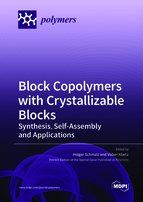Block Copolymers with Crystallizable Blocks: Synthesis, Self-Assembly and Applications
A special issue of Polymers (ISSN 2073-4360). This special issue belongs to the section "Polymer Analysis and Characterization".
Deadline for manuscript submissions: closed (31 October 2021) | Viewed by 28795
Special Issue Editors
2. Keylab Synthesis and Molecular Characterization, Bavarian Polymer Institute, University of Bayreuth, 95440 Bayreuth, Germany
Interests: Living and controlled polymerization techniques, block copolymer synthesis, crystallization driven self-assembly, Janus and patchy particles, mesostructured templates for heterogenous catalysis, Raman imaging of complex mesostructured polymer systems
2. Institute of Membrane Research, Helmholtz-Zentrum Hereon, Max-Planck-Straße 1, 21502 Geesthacht, Germany
Interests: self-assembly; block copolymers; polymer blends; nanocomposites; supramolecular polymers; membranes; controlled polymerizations
Special Issues, Collections and Topics in MDPI journals
Special Issue Information
Dear Colleagues,
Block copolymers with crystallizable blocks have recently moved to the forefront of current research owing to their unique self-assembly behaviour and properties. New synthetic concepts give, for example, access to tetrablock copolymers with four crystalline blocks, bio-based thermoplastic elastomers (e.g., based on ABA triblock copolymers with hard poly(L-lactide) (PLLA) segments), and conjugated semi-crystalline block copolymers for photovoltaics and allow for new, exciting insights into the interplay between the microphase separation and crystallization controlling self-assembly in bulk (confined vs. break-out crystallization).
Concerning self-assembly in solution, the pioneering work of Manners and Winnik paved the way to a myriad of crystalline-core micellar structures and hierarchical superstructures that were not accessible before via self-assembly of fully amorphous block copolymers. In analogy to living polymerization, crystallization-driven self-assembly (CDSA) can be conducted in a living manner using small micellar fragments as seeds for the addition of unimers (molecularly dissolved block copolymers bearing a crystallizable block). This allows for the production of cylindrical micelles with defined length, length distribution, corona chemistries (block type or patchy corona), branched micelles, and micellar superstructures (e.g., two-dimensional (2D) lenticular platelets, scarf-shaped micelles, multidimensional micellar assemblies, and cross and “windmill”-like supermicelles). Moreover, amphiphilic crystalline-core micelles based on PLLA or corresponding stereo-complexes (e.g., PLLA/PDLA (poly(D-lactide)) show interesting potential for biomedical applications (controlled release and delivery of drugs). Use of the process termed polymerization-induced crystallization-driven self-assembly (PI-CDSA) enables the one-pot production of a highly concentrated dispersion of crystalline-core cylindrical micelles.
This Special Issue aims to present a collection of articles describing new developments in the synthesis and self-assembly (bulk and solution) of block copolymers with crystallizable blocks. It also aims to address emerging applications for these exciting materials.
Dr. Holger Schmalz
Guest Editor
Manuscript Submission Information
Manuscripts should be submitted online at www.mdpi.com by registering and logging in to this website. Once you are registered, click here to go to the submission form. Manuscripts can be submitted until the deadline. All submissions that pass pre-check are peer-reviewed. Accepted papers will be published continuously in the journal (as soon as accepted) and will be listed together on the special issue website. Research articles, review articles as well as short communications are invited. For planned papers, a title and short abstract (about 100 words) can be sent to the Editorial Office for announcement on this website.
Submitted manuscripts should not have been published previously, nor be under consideration for publication elsewhere (except conference proceedings papers). All manuscripts are thoroughly refereed through a single-blind peer-review process. A guide for authors and other relevant information for submission of manuscripts is available on the Instructions for Authors page. Polymers is an international peer-reviewed open access semimonthly journal published by MDPI.
Please visit the Instructions for Authors page before submitting a manuscript. The Article Processing Charge (APC) for publication in this open access journal is 2700 CHF (Swiss Francs). Submitted papers should be well formatted and use good English. Authors may use MDPI's English editing service prior to publication or during author revisions.
Keywords
- block copolymer,
- semi-crystalline,
- self-assembly,
- crystallization driven self-assembly,
- bulk morphologies,
- hierarchical superstructures,
- biobased polymers








